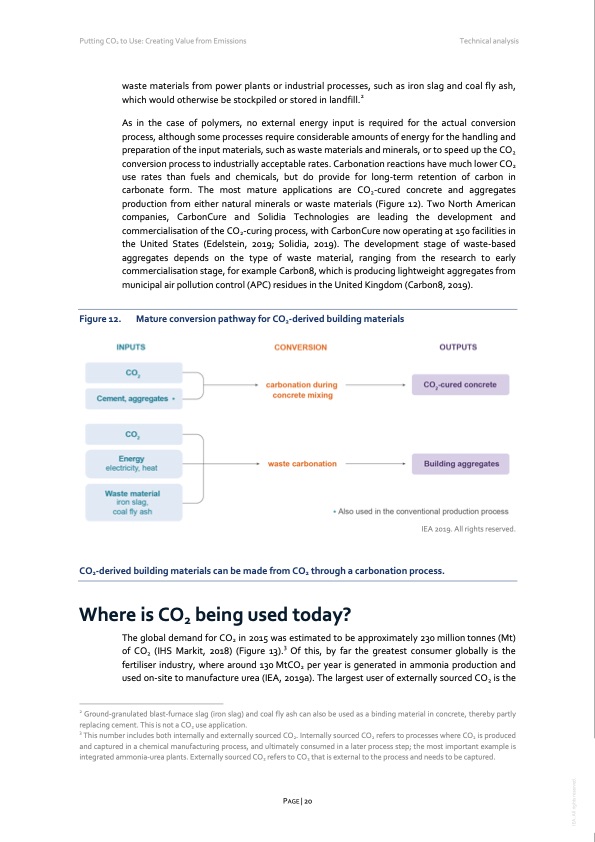
PDF Publication Title:
Text from PDF Page: 021
Putting CO2 to Use: Creating Value from Emissions Technical analysis waste materials from power plants or industrial processes, such as iron slag and coal fly ash, which would otherwise be stockpiled or stored in landfill.2 As in the case of polymers, no external energy input is required for the actual conversion process, although some processes require considerable amounts of energy for the handling and preparation of the input materials, such as waste materials and minerals, or to speed up the CO2 conversion process to industrially acceptable rates. Carbonation reactions have much lower CO2 use rates than fuels and chemicals, but do provide for long-term retention of carbon in carbonate form. The most mature applications are CO2-cured concrete and aggregates production from either natural minerals or waste materials (Figure 12). Two North American companies, CarbonCure and Solidia Technologies are leading the development and commercialisation of the CO2-curing process, with CarbonCure now operating at 150 facilities in the United States (Edelstein, 2019; Solidia, 2019). The development stage of waste-based aggregates depends on the type of waste material, ranging from the research to early commercialisation stage, for example Carbon8, which is producing lightweight aggregates from municipal air pollution control (APC) residues in the United Kingdom (Carbon8, 2019). Mature conversion pathway for CO2-derived building materials IEA 2019. All rights reserved. CO2-derived building materials can be made from CO2 through a carbonation process. Where is CO2 being used today? The global demand for CO2 in 2015 was estimated to be approximately 230 million tonnes (Mt) of CO2 (IHS Markit, 2018) (Figure 13).3 Of this, by far the greatest consumer globally is the fertiliser industry, where around 130 MtCO2 per year is generated in ammonia production and used on-site to manufacture urea (IEA, 2019a). The largest user of externally sourced CO2 is the 2 Ground-granulated blast-furnace slag (iron slag) and coal fly ash can also be used as a binding material in concrete, thereby partly replacing cement. This is not a CO2 use application. 3 This number includes both internally and externally sourced CO2. Internally sourced CO2 refers to processes where CO2 is produced and captured in a chemical manufacturing process, and ultimately consumed in a later process step; the most important example is integrated ammonia-urea plants. Externally sourced CO2 refers to CO2 that is external to the process and needs to be captured. Figure 12. PAGE | 20 IEA. All rights reserved.PDF Image | Putting CO2 to Use Creating value from emissions

PDF Search Title:
Putting CO2 to Use Creating value from emissionsOriginal File Name Searched:
putting_co2_to_use.pdfDIY PDF Search: Google It | Yahoo | Bing
NFT (Non Fungible Token): Buy our tech, design, development or system NFT and become part of our tech NFT network... More Info
IT XR Project Redstone NFT Available for Sale: NFT for high tech turbine design with one part 3D printed counter-rotating energy turbine. Be part of the future with this NFT. Can be bought and sold but only one design NFT exists. Royalties go to the developer (Infinity) to keep enhancing design and applications... More Info
Infinity Turbine IT XR Project Redstone Design: NFT for sale... NFT for high tech turbine design with one part 3D printed counter-rotating energy turbine. Includes all rights to this turbine design, including license for Fluid Handling Block I and II for the turbine assembly and housing. The NFT includes the blueprints (cad/cam), revenue streams, and all future development of the IT XR Project Redstone... More Info
Infinity Turbine ROT Radial Outflow Turbine 24 Design and Worldwide Rights: NFT for sale... NFT for the ROT 24 energy turbine. Be part of the future with this NFT. This design can be bought and sold but only one design NFT exists. You may manufacture the unit, or get the revenues from its sale from Infinity Turbine. Royalties go to the developer (Infinity) to keep enhancing design and applications... More Info
Infinity Supercritical CO2 10 Liter Extractor Design and Worldwide Rights: The Infinity Supercritical 10L CO2 extractor is for botanical oil extraction, which is rich in terpenes and can produce shelf ready full spectrum oil. With over 5 years of development, this industry leader mature extractor machine has been sold since 2015 and is part of many profitable businesses. The process can also be used for electrowinning, e-waste recycling, and lithium battery recycling, gold mining electronic wastes, precious metals. CO2 can also be used in a reverse fuel cell with nafion to make a gas-to-liquids fuel, such as methanol, ethanol and butanol or ethylene. Supercritical CO2 has also been used for treating nafion to make it more effective catalyst. This NFT is for the purchase of worldwide rights which includes the design. More Info
NFT (Non Fungible Token): Buy our tech, design, development or system NFT and become part of our tech NFT network... More Info
Infinity Turbine Products: Special for this month, any plans are $10,000 for complete Cad/Cam blueprints. License is for one build. Try before you buy a production license. May pay by Bitcoin or other Crypto. Products Page... More Info
| CONTACT TEL: 608-238-6001 Email: greg@infinityturbine.com | RSS | AMP |